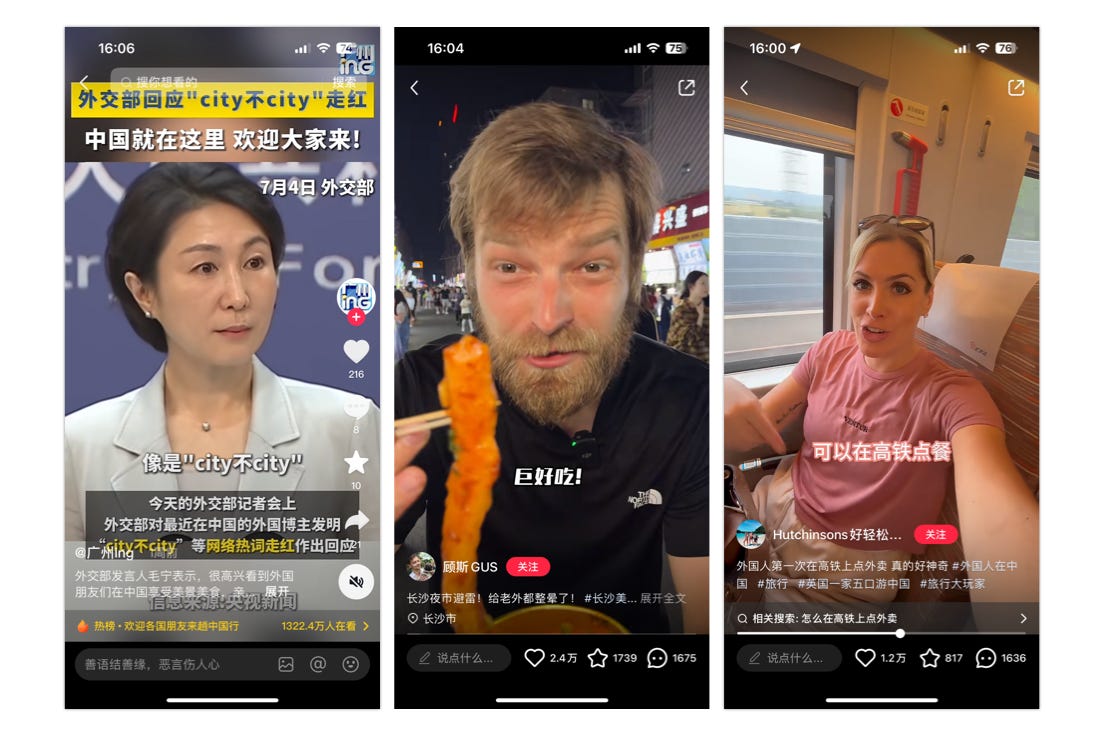'Lao Wai' takeover + Updates to WeChat Channels + Dishing out for Gelato
Summer updates coming in hot 🔥
It’s looking like a ‘Lao Wai’ summer
International tourists have become unexpected advocates of domestic travel in China with videos of their travels racking up billions of views on Chinese social media platforms.
Open Door: China recently implemented a 144-hour visa-free policy for 54 countries provided tourists enter China via an eligible port (37 options).
Beyond Beijing: Despite many being first-timers with limited language ability, many tourists are exploring beyond China’s major cities to discover more rural destinations, leading to humorous exchanges with locals about everything from language to cuisine to activities.
This new trend is highly visible on social media. Vlogs documenting foreigners' travels in China are flooding YouTube and TikTok, with "China Travel" becoming a go-to keyword for travel bloggers seeking high viewership.
On Chinese platforms like Xiaohongshu and Douyin (China’s TikTok), topics related to the "144-hour visa-free policy" and "foreigners traveling in China" have garnered millions of views.
The phrase “City不City啊”, coined in a video by Paul Mike Ashton, a Shanghai-based American, has been widely interpreted to convey themes of urbanization, fashion, novelty, and even excitement, and is being used in various contexts, including travel, fashion, and daily life.

Domestic influencers and celebrities have jumped on the “City不City” bandwagon, creating content that resonates with their followers, particularly the highly individualistic Gen Z.
Mao Ning, a spokesperson for the Chinese Ministry of Foreign Affairs, also made an official response to this phenomenon. Now, the topic has amassed over 86 million views on Xiaohongshu and over two billion views on Douyin.

WeChat Channels: New Growth Strategies and Opportunities for E-commerce
WeChat is revamping its Channels (video) platform to become a major player in e-commerce, integrating new strategies and opportunities for both brands and influencers.
Internal movements: The Live E-commerce team for Channels has now been integrated into the WeChat Open Platform team, further consolidating teams related to WeChat Mini Programs and other transactions.
Influencer Incentives: WeChat Channels officially launched the "Showcase Influencer Growth Level System (橱窗达人成长等级体系),” implementing a graded management system for influencers and clarifying corresponding benefits.
Access to e-commerce features:
Merchants now have no minimum follower requirement to leverage e-commerce functions for short videos or live-streaming
Threshold for influencers to use e-commerce live-streaming has been lowered from 1000 followers to just 100
Upgrades to user shopping experience introduced:
Instant refunds
Shipping insurance
“Try before you pay”
Easier conversion for WeChat Ads
WeChat Ads launched a direct link, supporting seamless jumps from Channels, Moments, Official Accounts, and Mini Program ads to the WeChat Channels Shop product page.
⚡️ This series of measures demonstrates WeChat’s determination to strengthen video-related e-commerce.
Who is spending on Channels: During this year's 618 shopping festival, consumers from first-tier, new first-tier, and second-tier cities accounted for more than half of the total e-commerce consumers on Channels.
Highly active users exhibit characteristics of long stays, low returns, and high repurchase rates.
Top performing categories on Channels during 618 were:
Clothing
Accessories
Jewelry
Hot categories for Channels live-streaming sales:
Fresh Food
Beauty Products

💡 Although WeChat Channels is still not as advanced in commerce and promotions as other platforms, it is receiving heavy investment and shouldn’t be ignored.
You scream, I scream, Young People Scream for $10 "Elite Ice Cream”
“Last year it was popular, and this year it’s even more so.”
This summer, many cafes, bakeries, and hotpot restaurants have added gelato to their menus. New entrants to the market are increasingly professional and high-quality.
Notably, Beijing-based gelato brand "Mr. Savage" (野人先生) has aggressively expanded, now operating over 168 stores across 18 provinces and cities, with plans for an additional 200 stores by year-end.

Other gelato brands are also thriving. Italian brand Venchi has over 60 stores in major Chinese cities, while Luneurs, the “ice cream benchmark of Shanghai,” boasts nearly 30 stores. Numerous small-scale chains like Dip in Gelato are also expanding.
On Xiaohongshu, #gelato has over 640 million views, on Douyin, the # has garnered over 490 million views.
Why are young people so enamored with expensive gelato?
Price
Transparent pricing on menus with most stores offering samples.
Health
Compared to American ice cream, which has a fat content of around 20%, gelato typically contains 4%-8% fat and is made primarily with milk instead of cream. Most gelato uses seasonal fruits, natural nuts, milk, and eggs, with no added water.
Just as the middle class prefers brands like Lululemon, Arc'teryx, and Salomon, gelato aligns with their healthy and individualistic lifestyle.
Additionally, gelato benefits from the trend against pre-packaged foods. Handcrafted products are in vogue, and gelato is made with fresh milk and fruits — easy for consumers to trust. Most gelato shops emphasize daily freshness, making this a major selling point.
It’s just… cool
Gelato offers social value. Its vibrant colors are highly photogenic, perfect for social media. The aesthetically pleasing décor of gelato shops makes them popular spots for young people to visit and share.
Chinese young people are not deterred by the $10 price tag for gelato; they appreciate the transparency and value that come with it.

Fascinated by the “City不City” trend? Yeah, us too. We spoke to Jing Daily on the topic, you can read more here 👇🏼
✌🏼
Thanks for reading the who what wai! We craft strategies and content that help our clients reach, engage, and foster relationships with Chinese consumers to drive long-term business results. Reach out to us at hello@waisocial.com to learn more 💬




